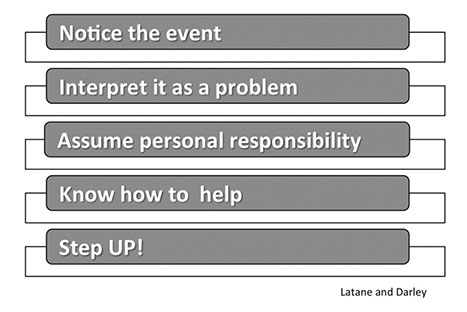The Step UP! Model
“Fear is such a powerful emotion for humans that when we allow it to take us over, it drives compassion right out of our hearts.” -Thomas Aquinas
Five Decision Making Steps

The Step UP! program teaches skills for intervening using the 5 Decision Making Steps. All five of these steps must occur if help is to be given. Failure at any one of the steps will result in no help.
Almost every reason a person can give for not helping falls into one of these 5 steps.
Though some of the reasons are understandable, educating people about these factors makes them more likely to help in the future.
1. Notice the Event
It’s easy to miss something you’re not looking for. People are busy, distracted on their phones, talking, texting, not aware of their surroundings – sometimes they don’t WANT to notice.
- PAY ATTENTION to what is going on around you. Always have an exit plan if necessary.
2. Interpret the Event as a Problem
There are 2 factors to consider here:
- Ambiguity: Is it a problem? Is it not? It’s sometimes hard to tell if someone is in need of help. How do you know for sure? Err on the side of caution and INVESTIGATE!
- Conformity: We are ALL exposed to group pressure.
- Informational Influence- when you think someone knows more than you do, or has more information than you, you will follow their lead.
- Pluralistic Ignorance- the majority know there is something wrong but no one else looks concerned so you think you must be the only one and thus don’t do anything
- Normative Influence- you go along with the group to fit in, to be liked or to be accepted by the group.
3. Assume Personal Responsibility
Research shows that if you are alone you will help 80% of the time but if you are in a group you will help only 20% of the time because of diffusion of responsibility – you think someone else will do something. But if not you, then who? Do not assume someone else will do something!
- Strategies:
- Do not rationalize away responsibility.
- Verbalize your intentions – you are more likely to help that way.
- Engage others – I’ll do A and you do B.
4. Know How to Help
Many times people WANT to help but they either don’t know what to do (knowledge) in a particular situation or how to do it (skills). NEVER put yourself in harm’s way but again, DO SOMETHING!
Be prepared – think about what you would do in certain situations so when and if that situation arises, you will have a game plan. It’s harder to think clearly when suddenly put in a difficult situation.
- Effective Helping: The Three D’s:
- Direct Intervention
- Distract
- Delegate
5. Implement the Help and Step UP!
The challenges at this step are there are always costs involved and the assumption is that when people decide on what actions to take they try to minimize cost and maximize rewards.
Costs could be something as simple as time but it could also be a fear of retaliation, you don’t want to embarrass yourself, you don’t want to go against the group; you don’t want to get yourself or your team/group in trouble; you are afraid the help will be ineffective, it could be dangerous, etc.





